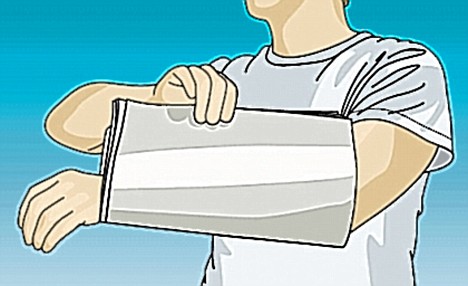Fractures of the Upper Limb
November 26, 2015 at 2:05 pm | Posted in Life as a Medical Student, Notes | Leave a commentTags: humerus, orthopedic notes, radius, ulnar, Upper limb fractures
P/s: As usual, I did not owe this note. Credit should be given to Appley and Netter’s Concise Orthopaedic and of course my lecturers 😉
1. Proximal humerus # in adult (elderly and osteoporotic)
Management depends on parts. (Neer Classification – head, GT, LT, shaft)
🔵 Undisplaced/minimally displaced: sling
🔵 2 fragments: closed reduction & splint.
🔵 3 fragments: operative
🔵 4 fragments: ORIF in young, may consider hemiarthroplasty in elderly.
Complications:
Shoulder stiffness
Brachial plexus injury
AVN (Anatomical neck #)
Nonunion
2. Shaft #
🐛Management:
Usually treated close (CMR + casting) as humerus heal readily. Complications following operative management higher.
ORIF (either plating/nailing) is still indicated in open #, severe comminuted #, polytrauma, unstable #.
🐛Humerus can accept more angulation due to presence of both elbow and shoulder joints.
Can accept up to <3cm shortening <20°AP angulation and <40° lateral angulation.
🐛Complications:
Distal 3rd #, radial nerve palsy, however mostly are neuropraxia. Why? Radial nerve in spiral groove, can become trapped easily.
3. Distal Humerus #
🐞In adults, mostly intraarticular, either bicondylar or unicondylar.
Extraarticular (supracondylar) but very rare.
🐞Management, as usual:
Undisplaced, treated close.
Displaced, need anatomical reduction, hence ORIF.
🐞Complications:
1. Ulnar nerve palsy. (Ulnar is situated posterior to medial epicondyle).
2. Median nerve palsy. (enters forearm at biceps aponeurosis)
3. Elbow stiffness
4. HO
4. Supracondylar # in children
:idea:Most common, extension type (posterior displacement), Gartland classification.
:idea:X ray: Fat pad sign. Fat pad at coronoid and olecranon fossa is displaced.
:idea:Management:
Gartland 1: casting
Gartland 2 & 3: CMR and k wire.
Children has good remodelling and thick cortex. K wire itself sufficent.
Rarely need ORIF. Still indicated for unreduced #, vascular involvement.
:idea:Complications:
1. Nerves injury
– Radial (between brachialis and BR @ posterior elbow)
– Median (jaggered fragments poke the median nerve/AIN)
– Ulnar
2. Vascular injury – brachial artery (same mechanism as median nerve injury)
3. Malunion – cubitus varus. Usually due to angulation.
5. Elbow dislocation
🌼Simple or Complex (with fractures of the surrounding structures). Posterior dislocation commonest.
🌼Terrible triad: Dislocation with radial head & coronoid #.
🌼Tx.
Simple – simply by closed reduction, then splint (collar and cuff for 1 week, start exercise after that, off by 3rd week)
Complex – settle the # first.
🌼Complications:
1. Nerve injury.
-Ulnar nerve (in cubital tunnel)
-Median nerve in Ligament of Struthers)
Both can become compressed
2. Vascular injury – Brachial artery
3. Elbow stiffness and instability.
➡ Recurrent dislocation very rare
6. Fractures of the Radius and Ulnar
Manage like an intraarticular #, needs anatomical reduction. Why? Presence of supinator and pronator muscle. Not easy to maintain reduction.
👉Both bone #
Paeds, closed reduction and casting. Remodelling is very good.
Adult, ORIF (plating)
👉Single bone #
Monteggia: Prox ulnar # with PRUJ disruption (radial head dislocation due to shortening force @ ulnar)
Mx: ORIF. Dislocation will reduce when # has been managed
Galleazi: Distal 1/3 radial # with DRUJ disruption
Mx: ORIF, DRUJ closed reduction.
7. Distal End Radius #
MOI: Axial force, FOOSH
Common, esp in osteoporotic pt.
✴ Colles #, dinner fork deformity ( dorsal displacement)
✴ Smith #, reverse Colles
Classification:
Frykman for Colles (joint involvement)
Even number – ulnar styloid #
1&2 Extraarticular
3&4 RC joint
5&6 RU joint
7&8 Both RC and RU involved
Management:
Undisplaced: cast
Displaced:
Extraarticular (close reduction, check X-Ray, Rule of 11). If unstable, ORIF
Intraarticular, need ORIF.
Old and osteoporotic ➡ allow more conservative mx as use the joint less.
Complications:
-malunion
-stiffness
-median nerve injury (carpal tunnel)
-TFCC injury (important for stability)
😇TFCC
Triangular fibrocartilage complex
-between distal ulnar and ulnar prox carpal row (triquetrium)
-Ligaments – central disc, dorsal radioulnar, palmar radioulnar.
8. Scaphoid #
Tenderness @ snuffbox region.
🔺Mx:
70% of scaphoid covered by articular cartilage, hence mx line intraarticular #.
Displace # need anatomical reduction (headless screw compression)
🔺Complications:
– AVN esp if injury at proximal part.
Blood vessel enters in a nonarticular ridge on the dorsal surface. Prox part supplied by retrograde blood flow.
– Non-union
Create a free website or blog at WordPress.com.
Entries and comments feeds.
